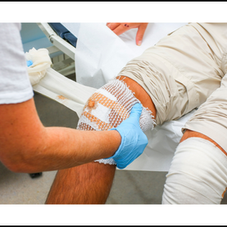Preventing the Spread of Contagious Illnesses: Understanding and Implementing Contact Precautions.
Understanding Contagious Illnesses
Definition and Examples
Modes of Transmission
The Importance of Contact Precautions
Definition and Purpose
Key Components
Implementing Effective Contact Precautions
Identifying High-Risk Individuals
Proper Hand Hygiene
Personal Protective Equipment (PPE)
Environmental Cleaning and Disinfection
Patient Placement and Isolation
Education and Training
Overcoming Barriers to Compliance
Promoting a Culture of Safety
FAQs (Frequently Asked Questions)
What is the duration of contact precautions?
Can contact precautions be lifted before the recommended duration?
Are contact precautions necessary for all contagious illnesses?
How can healthcare facilities encourage staff compliance with contact precautions?
Is contact tracing part of contact precautions?

Preventing the Spread of Contagious Illnesses: Understanding and Implementing Contact Precautions
Contagious illnesses pose significant risks to public health, and their prevention requires a comprehensive approach that includes understanding the nature of these diseases and implementing effective strategies to limit their transmission. One such strategy is the implementation of contact precautions, which aim to reduce the spread of contagious illnesses within healthcare settings and other environments where close contact is common. This article will delve into the importance of contact precautions, explore their key components, and provide insights on how to implement them effectively.
Understanding Contagious Illnesses
Before diving into contact precautions, it is crucial to have a clear understanding of contagious illnesses. Contagious illnesses are diseases that can be transmitted from one person to another through various means, such as direct physical contact, respiratory droplets, or contaminated surfaces.
The modes of transmission for contagious illnesses can vary. Some diseases primarily spread through respiratory droplets expelled when an infected person coughs or sneezes, while others can be transmitted through direct contact with bodily fluids or contaminated surfaces. Understanding the modes of transmission is essential in designing effective strategies to prevent their spread.
Examples of contagious illnesses that needs contact precautions
MRS WEE + COVID-19
MRSA (Methicillin-resistant Staphylococcus aureus)
Respiratory infections e.g RSV
Skin infections
Wound infections
Enteric infections
Eye infections
The Importance of Contact Precautions
Contact precautions are a critical component of infection prevention and control measures, particularly in healthcare settings. They are designed to prevent the transmission of contagious illnesses by interrupting the route of contact between infected individuals and susceptible individuals or their environment. Contact precautions involve a combination of infection control practices and protocols to minimize the risk of transmission.
The primary purpose of contact precautions is to protect healthcare workers, patients, and visitors from acquiring contagious illnesses within healthcare facilities. By implementing these precautions, healthcare providers can significantly reduce the spread of diseases and maintain a safe and healthy environment for all.
Key components of contact precautions include:
Hand Hygiene: Proper hand hygiene is paramount in preventing the transmission of contagious illnesses. Healthcare workers and individuals in close contact with infected individuals should perform hand hygiene using soap and water or an alcohol-based hand sanitizer.
Personal Protective Equipment (PPE): The use of appropriate PPE, such as gloves, gowns, masks, and eye protection, is crucial in limiting the transmission of contagious illnesses. PPE acts as a barrier between the infected individual and others, preventing the direct transfer of infectious agents.
Environmental Cleaning and Disinfection: Regular and thorough cleaning and disinfection of surfaces, equipment, and commonly touched objects help eliminate infectious agents and reduce the risk of transmission.
Patient Placement and Isolation: Proper patient placement and isolation techniques are essential to prevent the spread of contagious illnesses within healthcare facilities. Infected individuals may be placed in single-patient rooms or cohort units to minimize contact with others.
Education and Training: Comprehensive education and training programs for healthcare workers, patients, and visitors are crucial in ensuring proper adherence to contact precautions. Regular training sessions can reinforce the importance of these precautions and help overcome barriers to compliance.
Implementing Effective Contact Precautions
To implement contact precautions effectively, healthcare facilities and other environments should follow a systematic approach. Here are some key steps to consider:
Identifying High-Risk Individuals
Identification of high-risk individuals is essential for implementing appropriate contact precautions. This involves assessing the patient's medical history, symptoms, and laboratory test results to determine the likelihood of a contagious illness.
Proper Hand Hygiene
Hand hygiene is a fundamental practice that should be followed by healthcare workers and individuals in close contact with contagious individuals. It is recommended to wash hands with soap and water for at least 20 seconds or use an alcohol-based hand sanitizer when soap and water are not readily available.
Personal Protective Equipment (PPE)
The appropriate use of PPE is vital in limiting the transmission of contagious illnesses. Healthcare workers should wear gloves, gowns, masks, and eye protection based on the specific requirements of the situation.
Environmental Cleaning and Disinfection
Regular and thorough cleaning and disinfection of surfaces and equipment can significantly reduce the presence of infectious agents. Healthcare facilities should have protocols in place for routine cleaning and disinfection practices.
Patient Placement and Isolation
Infected individuals should be placed in appropriate settings to minimize the risk of transmission. Single-patient rooms or cohort units can be utilized based on the nature of the contagious illness.
Education and Training
Continuous education and training programs should be implemented to ensure that healthcare workers, patients, and visitors are aware of the importance of contact precautions. These programs should cover proper hand hygiene, the correct use of PPE, and other relevant infection control practices.
Challenges and Best Practices
Implementing contact precautions can present challenges within healthcare settings. Some barriers to compliance may include staff resistance, lack of resources, or limited patient cooperation. Overcoming these challenges requires a multifaceted approach that includes education, support, and a strong organizational commitment to patient safety.
Promoting a culture of safety and infection prevention is crucial in achieving optimal compliance with contact precautions. This involves engaging all stakeholders, providing ongoing education and feedback, and fostering an environment that encourages open communication and collaboration.
Preventing the spread of contagious illnesses is a vital aspect of public health. By understanding the nature of these diseases and implementing effective contact precautions, we can significantly reduce their transmission within healthcare settings and other environments. Proper hand hygiene, the use of personal protective equipment, environmental cleaning and disinfection, patient placement and isolation, and education and training are essential components of successful contact precautions implementation. By prioritizing these measures, we can create safer and healthier environments for everyone.
FAQs (Frequently Asked Questions)
What is the duration of contact precautions? The duration of contact precautions may vary depending on the specific contagious illness. Healthcare providers typically follow guidelines and recommendations provided by public health agencies and medical experts.
Can contact precautions be lifted before the recommended duration? Contact precautions should be maintained for the recommended duration to ensure the complete containment of contagious illnesses. Premature removal of precautions can increase the risk of transmission.
Are contact precautions necessary for all contagious illnesses? Contact precautions are not necessary for all contagious illnesses. The need for contact precautions is determined based on the mode of transmission, infectiousness, and other factors specific to each illness.
How can healthcare facilities encourage staff compliance with contact precautions? Healthcare facilities can encourage staff compliance by providing comprehensive education and training, fostering a culture of safety, providing necessary resources and support, and implementing systems for monitoring and feedback.
Is contact tracing part of contact precautions? Contact tracing is a separate process that involves identifying and monitoring individuals who have been in close contact with someone diagnosed with a contagious illness. While contact tracing and contact precautions share a common goal of preventing transmission, they are distinct processes with different objectives.





















Comments